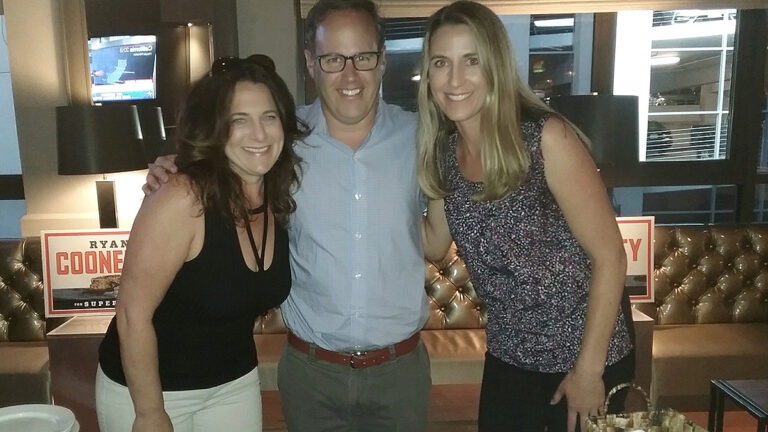Because many in-person events across Santa Cruz County have been canceled or postponed during the pandemic, Good Times is compiling a weekly list of virtual events hosted by local nonprofits, artists, fitness instructors and businesses. To submit your virtual event, send an email to ca******@*******es.sc.
ARTS AND MUSIC
ANTHONY ARYA: LIVE AT MICHAEL’S ON MAIN On Saturday, June 27, Michael’s on Main is presenting a seated, very limited capacity show at 8:30pm. Seating will be at socially distanced tables. Due to very limited capacity, tickets will only be sold that include “Dinner and A Show” together for one price. Table reservations are for two or more. Dinners start at 6:30pm and showtime is at 8:30pm. You can make your reservations, which will be secured by a credit card, by calling 831-479-9777 (ext. 2). If you call during off hours, please leave name, number of tickets and phone number and you will get a call back Tuesday through Saturday.
CONNECTIONS: A VIRTUAL PRINTMAKING EXHIBIT View the virtual Resource Center for Nonviolence “CONNECTIONS” Printmaking Exhibit online through July 31 at rcnv.org/programs/rcnv-exhibits-the-art-of-nonviolence. In this time of the coronavirus and sheltering at home, we yearn for connection. These prints link us to the healing power of nature, our history and our memories. They provide a window of hope for the current moment. The art helps us to remember the past and to face the future. Features eleven artists: Jody Bare, Molly Brown, Marcus Cota, Esmeralda DeGiovanni, Emma Formato, Jane Gregorius, Anita Heckman, Bridget Henry, Glenn Joy, Stephanie Martin and Melissa West. The exhibit has moved online due to Covid-19, since RCNV is temporarily closed to the public. For more information: an***@**nv.org.
JOURNEY TO HOKUSAI: VIRTUAL FILM SCREENING Catch a screening of Journey to Hokusai with Tom Killion and Chikara Motomura. This film, created by Chikara Motomura, follows local artist Tom Killion as he journeys to Japan to learn traditional printing from Kenji Takenaka—a fifth generation printer in Kyoto. All current MAH Members are invited to a private Q&A with Chikara Motomura and Tom Killion following the screening. Members will be sent a link upon RSVPing. This event is limited to the first 300 people who log in to the Zoom meeting. Please email us at in**@**********ah.org with any questions. Thursday, June 25, 6pm.
EBB AND FLOW RIVER ARTS FESTIVAL 2020 Starting Friday, June 5, the community is invited to celebrate the San Lorenzo River through public art installations, virtual performance, and activities as part of the Ebb and Flow River Arts Festival. In its sixth year, Ebb and Flow 2020 will continue to deepen and inform the Santa Cruz community’s relationship with the San Lorenzo River and the Tannery Arts Center through creative educational activities and storytelling. Permanent and temporary public art will be at the center of this year’s celebration. Local artists are designing works that will elevate water literacy, connect us to the land and its history, cultivate our sense of belonging, and inspire curiosity about the impact we have on the river system. Learn more at ebbandflowfest.org.
SPEED SKETCHING Come with paper and pencil and try your hand at speed sketching: all artistic experience is welcome. Prior to beginning the program, please select an object in your home and place it in view of your computer’s camera and let’s have fun together and see who can draw the silliest, stylish, true to life, or abstract interpretation of it. Every Tuesday afternoon at 2pm, take a break out of your day for some fun! Register for Zoom at: santacruzpl.libcal.com/event/6780189.
MIKE THE MAGICIAN Magician Mike Della Penna creates wonder and laughter with family magic performances that are equal parts playful and astonishing! He is a favorite at preschools, libraries and family venues and is known for captivating the 3-to-7-year-old crowd with his fun-filled, participatory magic shows. Wednesday, June 24, 11am; Tuesday, July 7, 1pm. Visit santacruzpl.org for more information.
CLASSES
SALSA SUELTA IN PLACE: Free weekly online session in Cuban-style Salsa Suelta for experienced beginners and up. Contact to get a Zoom link. Thursdays at 7pm. salsagente.com.
VIRTUAL CHEESE TASTING WITH STAFF OF LIFE AND ESSEX CHEESE A lesson and guided tasting traversing five different European countries and experienced through the lens of five distinct producers. The iconic cheeses represented in this online seminar have rich histories whose traditional methods of production have seen a resurgence in popularity in modern consumer markets in part because of the efforts of the team at Essex Street Cheese. Essex Cheese is an importer of cheese focusing on a handful of cheeses. To tell you about how the cheeses are selected for the Essex brand as well go over production and producer specifics we have Rachel Juhl, chief educator and trainer for Essex. Join us for this rare opportunity to take a course from an industry professional like Rachel. Cost is $45 per person and includes a personal cheese tasting package. Tickets and more info: eventbrite.com/e/staff-of-life-and-essex-cheese-virtual-cheese-tasting-class-tickets-109377250300. Saturday, June 27, 6:30pm.
COMMUNITY
STERLING THE BUBBLESMITH The artist Sterling Johnson has performed versions of his remarkable hand-blown bubbles for over 45 years. He is the only person to ever put a bubble inside a bubble inside a bubble on stage without any tubes or straws, and the first person to walk completely through a bubble film! Come join us for this exciting and popular show. This program is part of our Summer Reading Program, Imagine Your Story. Register online: santacruzpl.libcal.com/event/6741389. Thursday, June 25, 11am.
2020 SUMMER LUNCH PROGRAM Children and youth aged 18 and under can get free lunches this summer at 12 sites throughout Santa Cruz County! The annual Summer Lunch program, sponsored by La Manzana Community Resources, a program of Community Bridges, combats food insecurity and supports good nutritional habits. The Summer Lunch program begins June 8 and serves lunch Monday through Friday from 12-1pm. Free meals will be provided to all children, without eligibility documentation, who are 18 years of age and younger. Visit communitybridges.org/lmcr for more information.
KIDS CREATE STEAM PROJECT SERIES Series of STEAM programs through the summer for kids of all ages, presented via Facebook and our YouTube channel. Look for new videos on Tuesdays at 3:30pm and Fridays at 10am through July. Check out our Facebook (facebook.com/santacruzpl/) and YouTube channel (youtube.com/user/SantaCruzPL).
LEGO BUILDING CHALLENGE Join our eight-week summer Lego Building Challenge. You will only need common Lego pieces to complete these challenges. To join the fun, register each week via our online calendar, June 10 through July 29. On Wednesday, you will receive an email with the weekly challenge. If you would like to share your creation, post a photo on our Facebook SCPL Lego Building Challenge webpage. Bonus building challenges will be posted there for intermediate-level Lego fans. Learn more at santacruzpl.org.
TALES TO TAILS GOES VIRTUAL Tales to Tails goes virtual to create a comfortable, neutral, and fun reading experience. Bring some books, a stuffed animal or your own pet, and come read with us! This is a YouTube livestream event so you might be reading to up to six animals at once. Woo hoo! Caregivers, you can post your child’s first name and city in the comments section, along with the book they are reading, and we’ll read off as many of those names as we can, live, during the break we need to give the dogs. Each week you register we’ll send you your dog bone “punch cards.” These will be dated dog bones your child can color and email to us. The following week, we’ll display them live on the feed. This will also be recorded so if you can’t make it live, the dogs will still be there for you. Every Wednesday, 10-11am. Learn more at santacruzpl.libcal.com/event/6764929.
PEOPLE AND STORIES: READING DEEPLY IN COMMUNITY People and Stories is dedicated to opening doors to literature for new audiences. Through oral readings and rigorous discussions of enduring short stories, we invite participants to find fresh understandings of themselves, of others, and of the world. Please note that some stories contain themes and language of an adult nature. Santa Cruz Public Libraries offers People and Stories regularly in our county jails. We invite you to our special eight-week session on Zoom! Drop in for one or attend all eight People and Stories sessions! Wednesdays, June 10-July 29, 1:30pm. Learn more at santacruzpl.libcal.com/event/6760931.
THE BIG NIGHT IN REPLACES BOWL FOR KIDS’ SAKE 2020 For the first time in our history, we’ve had to cancel all live events including our signature Bowl for Kids’ Sake, which represents a significant portion of our annual budget. This change has the potential to disrupt services to the youth we serve. We find ourselves in an urgent situation that we hope can be remedied by a temporary campaign asking many to give a little. Since we are not able to join together to bowl this year as planned, we want to offer a way for the community to support our work as well as provide fun ways for people to have community during this unique period of sheltering in place and social distancing. Instead of having a Big Night Out like we used to and will again, we are inviting you to have a Big Night In. This campaign will run May 15-June 30. It is a virtual fundraiser that is all about having fun and supporting a great cause, 1:1 youth mentoring. To encourage and promote your participation, fun and fundraising, we will be holding Weekly Drawings throughout the campaign window. A variety of gift certificates will be awarded each week. One week we will even be raffling off exclusive California wines for those that are over 21. We will also be offering Grand Prizes to the top individual(s) and team fundraiser(s). The organization is also seeking larger donations that can be used to match campaign donations and that info can also be found on our campaign website. Learn more at amplify.netdonor.net/13981/bfks2020.
GROUPS
SUNSET BEACH BOWLS Experience the tranquility, peace and calmness as the ocean waves harmonize with the sound of Crystal Bowls. Every Tuesday at 7:45pm. Moran Lake Park.
VIRTUAL YOUNG ADULT (18-30) TRANSGENDER SUPPORT GROUP A weekly peer support group for young adults aged 18-25 who identify as transgender, non-binary, genderqueer, agender, or any other non-cisgender identity. This is a social group where we meet and chat among ourselves, sharing our experiences and thoughts in a warm, welcoming setting. Our meetings will be held on Discord during the shelter-in-place order. For more info, contact Ezra Bowen at tr***@*************er.org.
LGBTQNBI+ SUPPORT GROUP FOR CORONAVIRUS STRESS This weekly LGBTQNBI+ support group is being offered to help us all deal with stress during the shelter-in-place situation that we are experiencing from the coronavirus. Feel free to bring your lunch and chat together to get support. This group is offered at no cost and will be facilitated by licensed therapists Shane Hill, Ph.D., and Melissa Bernstein, LMFT #52524. Learn how to join the Zoom support group at diversitycenter.org/community-calendar.
OUTDOOR
A TALE OF TWO PARKS – VIRTUAL Join us for a joint exploration of two beloved state parks in the Santa Cruz Mountains: Henry Cowell Redwoods and Castle Rock! We’ll share stories, music, and trivia with you as we dive into the differences and similarities between these local hot spots. Unfortunately Zoom does not yet have a food sharing option, so this campfire is BYOS: Bring Your Own S’mores! This interactive program will be simultaneously broadcast as a Zoom webinar and a Facebook Live. Registration is required for the Zoom webinar. To register, visit tinyurl.com/SantaCruzCampfire. Like our Facebook page to receive a notification when we go live! facebook.com/HenryCowellRSP. If you are unable to join us live, this program will be recorded for later viewing. Free event. Saturday, June 27, 7pm.
LABSIDE CHATS: A CONVERSATION WITH A SCIENTIST Tune in for the next Labside Chat with Eric Palkovacs, director of the UCSC-NOAA Cooperative Institute and associate professor of Ecology and Evolutionary Biology, on Thursday, June 25, at 11am, to explore the unique characteristics of freshwater and coastal watershed ecosystems. Submit your questions in advance for Eric, then watch the conversation to hear the answers during the live chat. Visit the Seymour Center’s website to submit your questions in advance and to access the livestream at: seymourcenter.ucsc.edu/learn/ongoing-education/labside-chats. Virtual Labside Chats are offered at no charge. Please support the Seymour Center by becoming a member or making a donation today: seymourcenter.ucsc.edu/get-involved/join.
SEYMOUR CENTER’S OCEAN EXPLORERS VIRTUAL SUMMER CAMP Ocean Explorers experience the thrill of scientific discovery at a working marine lab. Join the Seymour Marine Discovery Center for behind-the-scenes virtual visits, live streaming interactions with scientists and animal trainers, and much more! Children actively learn in a distance learning format. Enjoy a week of fun this summer learning about ocean science. Investigate the incredible creatures that inhabit Monterey Bay. Discover how ocean scientists work with marine animals at the Seymour Marine Discovery Center and Long Marine Lab to help conserve animals in the wild. Space is limited–APPLY NOW! Masterful Marine Mammals, ages 9-11, June 22-26, July 13-17, and August 3-7. Masterful Marine Mammals, ages 12-14, June 15-19, June 29-July 3, and July 20-24. Something’s Fishy, ages 7-9 (waitlist only), July 6-10. Marine Science for Girls, ages 9-11, (waitlist only), July 27-31. Programs run 10:30am to 2:30pm (1-hour lunch break from 12-1pm): varied activities and mini-breaks. Fees: Members $250 (was $610); General Public $300 (was $650). Learn more at seymourcenter.ucsc.edu/learn/youth-teen-programs/ocean-explorers-summer-camp.




























